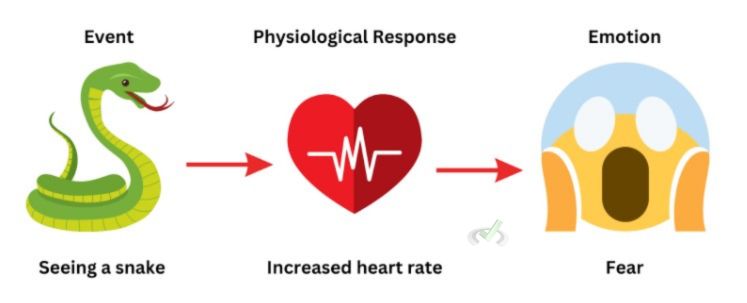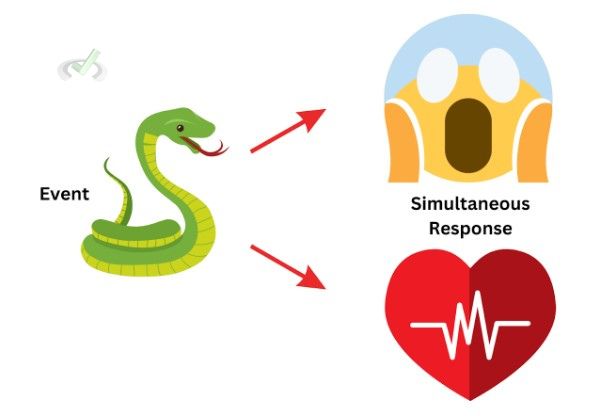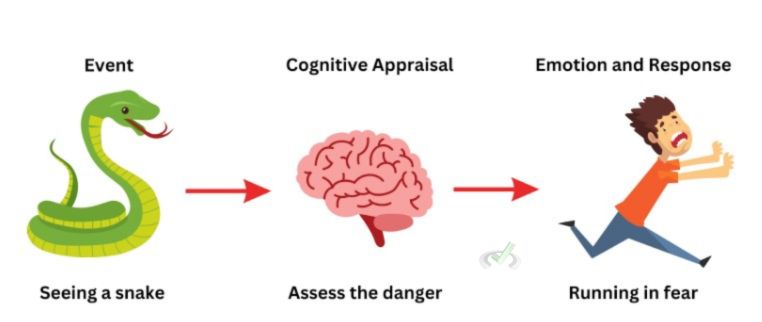Emotions are powerful and complex responses to different situations. They can influence our thoughts, actions, and physical states.
Understanding how emotions work is crucial in psychology. Emotions help us understand ourselves and interact with others.
Over the years, psychologists have proposed various theories to explain emotions. Let's explore some of the significant theories of emotion.
I. James-Lange Theory
The James-Lange Theory is one of the earliest theories of emotion. William James and Carl Lange proposed it in the late 19th century.
This theory suggests that emotions occur due to physiological reactions to events. In other words, our body reacts to a situation, and then we experience an emotion.
Order of Events
The theory states that the sequence of events in experiencing emotion is as follows:
- Event: Something happens (e.g., seeing a snake).
- Physiological Response: The body reacts (e.g., increased heart rate, sweating).
- Emotion: The brain interprets these physical changes as an emotion (e.g., fear).

Implication
This theory implies that if we can control our physiological responses, we can control our emotions.
For example, imagine you're walking in the woods, and you see a snake. Your body immediately responds with a racing heart and sweating.
According to the James-Lange Theory, you feel fear because your body reacts this way. This means your physical reaction happens first, and you feel the emotion.
II. Cannon-Bard Theory
Walter Cannon and Philip Bard developed this theory in response to the James-Lange Theory. They argued that we feel emotions and experience physiological reactions simultaneously, not one after the other.
Simultaneous Response
This theory suggests that when an event occurs:
- Event: Something happens.
- Simultaneous Response: The brain sends signals, simultaneously causing emotional and physical reactions.

Brain's Role
The thalamus (a part of the brain) plays a vital role in this process. It sends signals to the cortex (which interprets the emotion) and the hypothalamus (which controls the physiological response).
For instance, let's use the same snake scenario to illustrate the Cannon-Bard Theory. It suggests that when you see the snake, your brain simultaneously makes you feel fear and triggers your body's physical response. This means your emotions and body reactions happen at the same time.
III. Schachter-Singer Theory (Two-Factor Theory)
Also known as the Two-Factor Theory, it was proposed by Stanley Schachter and Jerome E. Singer. This theory suggests that emotion is based on physiological arousal and cognitive labels.
Two Factors
- Arousal: The body reacts (e.g., heart rate increases).
- Cognitive Label: You identify a reason for the arousal (e.g., "I am scared because there is a snake").
- Emotion: You then feel the emotion based on the label (e.g., fear).

Context Matters
This theory emphasizes that the physiological response is crucial for determining emotion. Different contexts can lead to other emotions from the same physiological state.
For example, if you see a snake, your body might respond with an increased heart rate. You then think about why your heart is racing, realize it's because of the snake, and conclude that you are afraid. This theory emphasizes that our thoughts help determine our emotions.
IV. Lazarus Theory
Developed by Richard Lazarus, this theory emphasizes the role of cognitive appraisal in the emotion process. It suggests that our evaluation of a situation determines our emotions.
Cognitive Appraisal
- Primary Appraisal: You evaluate the event's significance (e.g., is the snake dangerous?).
- Secondary Appraisal: You assess your ability to cope with the event (e.g., can I escape the snake?).
Emotion and Response
Your appraisal leads to an emotion that triggers a physical response.

For instance, seeing a snake might first lead you to assess the danger. If you decide the snake is a threat, you feel fear, and your body reacts (e.g., increased heart rate). This theory highlights how we think about a situation influences our emotional response.
V. Bridge/Overlap
Understanding the major theories of emotion also helps us grasp how these theories can overlap and interact. Each theory offers a unique perspective, and they often intersect to explain complex emotional and behavioral responses.
Stress Responses
he body's reaction to stress involves both physical and emotional components. For instance, the fight or flight response involves increased heart rate and adrenaline release.
This ties into the James-Lange and Cannon-Bard theories. Both physical reactions and emotions are important in stressful situations.
Cognitive Processes and Behavior
Cognitive processes, like how we label and appraise situations, can influence our actions. This is evident in the Schachter-Singer and Lazarus theories. Understanding these connections can help in fields like behavioral psychology and neuropsychology.
VI. Wrap-Up/Key Terms
Understanding the major theories of emotion helps explain why we react to situations the way we do. Each theory provides a unique perspective on the relationship between our bodies and emotions.
Key Terms
- James-Lange Theory: Emotions follow physiological responses.
- Cannon-Bard Theory: Emotions and physiological responses occur simultaneously.
- Schachter-Singer Theory: Emotion results from physiological arousal and a cognitive label.
- Lazarus Theory: Emotions are based on the appraisal of a situation.
VII. Practice Questions
Sample Practice Question 1
Which theory suggests that emotions and physiological reactions occur at the same time?
A. James-Lange Theory
B. Cannon-Bard Theory
C. Schachter-Singer Theory
Ans. B
The Cannon-Bard Theory proposes that emotions and physiological responses occur simultaneously. This is because the brain sends signals to cause both reactions at the same time.
Sample Practice Question 2
According to the Schachter-Singer Theory, what two factors are necessary for emotion?
A. Event and Response
B. Arousal and Cognitive Label
C. Appraisal and Response
Ans. B
The Schachter-Singer Theory states that emotion results from physiological arousal and the cognitive interpretation or labeling of that arousal.







 To help you achieve your goal MCAT score, we take turns hosting these
To help you achieve your goal MCAT score, we take turns hosting these 





















 reviews on TrustPilot
reviews on TrustPilot